With an oxymoron, we could summarize almost the whole situation: fixed change. If we look at the 2023 indicators and the 2024 trends, this international chronicle reaffirms the idea of a constant change that comes from hand to hand with digitization, with no news on the front lines in that sense. The process of digitization continues and collects the highest figures in history: it exceeds the five-billion barrier.
The data, conclusions and suggestions we will use in this summary have been collected from three sources: Digital News Report 2023 by Reuters Institute (Newman et al., Report 2023); Journalism, Media and Technology Trends and Predictions Report (Newman, 2024), of the same origin; and Digital Report 2023 Global Overview Report, one of the pioneers in network data monitoring and analysis, published by the company Meltwater in collaboration with We Are Social (takes data from various sources and informative purposes only). Their worldview also depends on each other"s characteristics, but we hope they will help us to have a global perspective.
Highlights of 2023 studies
The results of surveys conducted by the Reuters Institute in 46 countries around the world (11 Asia-Oceania, 5 South America, 3 North America, 3 Africa and 24 Europe countries) show that structural changes have accelerated due to violent situations in the last four years (pandemic and, according to this report, conflicts between Russia and Ukraine in the most mobile and digital business models).
Regarding consumption habits, only 22% of respondents prefer to search for information from the web or application, an option that has dropped 10 points since 2018. Some editors from small countries in northern Europe have managed to avoid this trend, but young people from all places show a weaker relationship with the websites and media applications, prefer networks, searches or mobile aggregators to access news (they have analyzed in depth the consumption of young people here in Garazi Sánchez and its members in the article Youth and information published in this same issue).
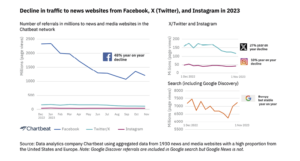
In general, Facebook remains one of the most used networks, but its influence on the world of information and journalism decreases to the same extent that it distances its focus of information. In addition, it has stabilized platforms such as Youtube or more dynamic platforms such as Tik Tok for young people, which reaches 44% of those aged 18 to 24 in all markets and 20% in the use of information. The fastest growth of this platform has been recorded in Asia-Oceania, Africa and Latin America.
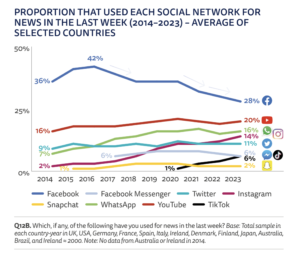
In terms of information and news, users of platforms such as Tik Tok, Instagram or Snapchat pay more attention to celebrities, influencers and network personalities than journalists. On the contrary, on Facebook and X, the media and journalists are the focus of attention and dialogue.
There are many people who are skeptical about the algorithms that determine what you see on search engines and platforms. Less than a third (30%) say that it is a good way to receive news that is algorithmically classified based on previous consumption, which has resulted in a 6 point drop from the same question in 2016. In any case, users value this news classification made by algorithms on average against the news classification made by journalists (27%), so this concern for the algorithms is part of a broader concern about the nature of the news and how to select and classify it.
Despite the widespread belief that the Internet was going to open a democratic debate, today, online news reports show a lower share than in the recent past. Only a fifth of respondents (22%) actively participate and about half (47%) do not participate in any event. In the UK and the US, the percentage of active participants has decreased by more than 10 points since 2016. From the point of view of all countries, in this group of participants they are mostly men, of higher educational level and more partisan in political opinions.
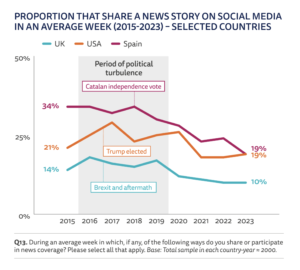
Confidence in the news has dropped by 2 points in the last year and some countries have reversed in the progress made at the highest moments of the pandemic. On average, four out of ten claim to trust most of the news. Finland remains at the highest global level of confidence (69%) and, at the other end, Greece (19%), which has had a conflicting year, with strong debates on press freedom and newspaper independence.
Public media are the most trusted in many countries in northern Europe, but this perception is losing strength among young people. This is important because those who use these public services more frequently are more likely to see public media as important at a personal and social level. According to these data, maintaining this good perception of these media is fundamental for future legitimacy, especially for the youngest.
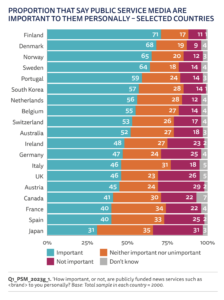
Consumption of traditional media, such as television and print media, continues to fall in most markets, and this decline is not offset by net consumption. Consumers in the network use less news than in the past and show less interest. Due to political and economic problems, less than half of the respondents (48%) reported being very or very interested in the news; in 2017, 63% answered this question.
In the same vein, the group of people who sometimes or often avoid news remains in the historical majorities, which represent 36% of the respondents. The report shows that this block can be divided into two, on the one hand, in which an attempt is made periodically to avoid any source of news and, on the other, in which occasional or thematic news is avoided. Supporters of avoiding it tend to claim that they"re interested in positive or solution-based journalism, but not the great stories of the day.
If asked if they prefer to read, listen or hear news, receivers still place reading first, although the trend of younger audiences suggests that this classification will be different in the next decade. The text offers greater agility and control when consuming information and, on average, 57% prefer to read globally. The exception is India, Thailand and the Philippines, which prefer video over the other two. The general tendency to receive video information has grown and access to most of the content is made through third party platforms, especially Youtube and Facebook, which Tik Tok is approaching among those under 35 years of age.
Podcast consumption remains in last year’s figures, with 34% listening to at least one session a month. Although the journalistic genre remains in a minority, it has its place in the set of young audiences and with studies, among which the ones that listen the most are those that deepen the themes and those that concentrate long conversations or tertulias. There is also a growing interest in the hybrid podcast that accompanies the video.
In analysing the tendency to pay for the news, the overall increase in the way of life is also found in this report. Thus, the presumption of the budgets of families and private households, together with the sufficiency of free information on the network for a significant part of the users, indicates that the growing trend of online news payments is stabilized. Those who pay, for their part, add value to the quality of their content (click against the invasion of the bait), to their good journalism, to their adherence to the mark and/or to their political identification and, to a lesser extent, to their non-informative offer (hobbies, etc. ).

If you take the 20 richest countries that have studied in more detail, 17 percent of the average paid for news from the network, the same figure as the year before. Norway is at the top with 39% and, at the last end, with 9%, Japan and the UK. The reasons most indicated by those who have canceled their subscription in the last year are the increased life and the high price. in EE.UU. Germany and the United Kingdom, almost half of the unpaid are clear that they will not pay for online news; the main obstacles to this remain lack of interest and perceived value.
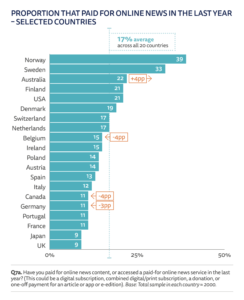
If we look at the markets by country, the model of previous years is repeated; most digital subscriptions are concentrated in a few state media, which are primarily a single subscription, a great media outlet. In four of these 20 countries, readers have an average of two subscriptions: Australia, United States and Spain and France.
Internet stands ahead of television in Spain
For the first time, more population (84.3%) has sailed the network that has watched television (83.3%), according to the AIMC media analysis association. This has continued the downward trend in paper media, with the number of daily readers below 6 million. According to AIMC, the sector has lost 60% of its readers in the last decade and has found new revenue in paid news online since 2019; according to media data, El País is the country with the largest number of subscribers of the network, of which 264,000 are subscribers exclusively to the network. Despite the growth in subscriptions, the sector continues to rely heavily on advertising revenue. Financial pressure has forced most publishers to strengthen network subscription strategies and redesign network and paper editions.
Moreover, the General Audiovisual Law of Spain will regulate streaming platforms and vloggers for the first time, and will raise the budget of the public body RTVE by increasing taxes on private broadcasters, which have amounted to EUR 530 million in 2023.
Interest in news in the French state is decreasing
The number of people most interested in news is 36% in the French state, compared with 59% eight years ago.
According to the Digital News report 2023, so is the number of people claiming to avoid news sometimes or often appropriately (36%), avoiding news or scrolling (24%) or refusing notifications (13%). Despite the low level of payment subscription (11%), there has been no increase in this area. However, some payment offers are successful and the respondents have, on average, two subscriptions, a non-globally normal situation. The newspaper Le Monde, with 547 journalists, is the one with the largest subscribers of the network (almost 500,000), with an increase of 25% in the last year.
In the audiovisual field, the authorities have abandoned the idea of unifying the M6 and TF1 televisions, leaving aside the future French project Salto. The French Government has also suspended the annual TV licence tax (€138), replacing it with a public budget line. In addition, the public body France TV will remove from the regional network France 3 national news for more news from the area and more content from the network. Finally, it should be noted that all major media have agreed on thirteen points of action in response to the climate emergency.
Over 5 billion Internet users
The world"s population has already exceeded the eight billion mark, of those living in urban or urbanized environments almost 58%, with an average age of 30.6 years. Five and a half billion mobile phones are unique users (95% of phones are smart) and the number of Internet users is similar: around five and three hundred and fifty million (5.35 billion). Here are some of the data from the Digital Global Overview Report 2023 (with some updates from the first month of 2024) by Meltwater and We are Social, which show the degree and speed of diffusion of digitisation.
It is also interesting to see the distribution of the average consumption times in the same report, that is, the time each user spends on each medium per day. For example, Internet usage is 6 hours and 40 minutes, time spent on social media (2 hours and 23 minutes), time spent listening to music by streaming (1 hour and 25 minutes), time spent listening to podcasts (49 minutes) or part of television consumption combined with offline modes (3 hours in total) and press (1 hour and 40 minutes in total). The following figure shows the following temporal distribution:
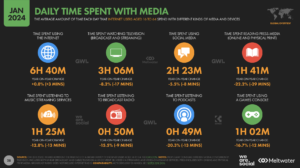
Arrival and arrival: trends
The technological advance that has crossed the atmosphere of communication, has fully penetrated and begun to expand like never in the last year has been a set of resources known as Artificial Intelligence (AI). As Nic Newman says in his Journalism, Media and Technology Trends and Predictions 2024, “technology goes at full speed, far above the ability of most of us to internalize it.” That is why the author of this report foresees that one of the tasks of the media will be the construction of different content and experiences that are difficult to replicate for the AA. These include live news, in-depth analysis, human experiences conducive to interaction, as well as longer audio and video formats than the text itself.
But we must also insist on the use of AA, which will have to seek the efficiency of the business in an increasingly economically complex environment. They will also focus on the development of packaging and content dissemination formats that allow the different audiences to reach more strongly, in order to increase adherence and avoid discrimination of news.
Predicting the influence of NR on the broad platform environment is more difficult for the author. On the one hand, it depends on the evolution of new attitudes towards technology, which are its beginnings, and on the other, on the responsibility that the platforms acquire in this collision between accelerators and collapses. It will also be important to see what happens with intellectual property conflicts, as there may be cases of opening or closing pathways in which the content of AA training news is scarce.
According to you responsible for the media involved in the drafting of the report, the poetry of unreliable synthetic content will strengthen the position of journalism and will regain the value of reliable content. Others, however, are concerned that people may lose all their confidence in all the information, damaging democracy itself globally. The 2024 gives us new indications to see which of these hypotheses will take more force and what is the willingness of governments to regulate the power of AA giants. Just over a year ago the ChatGPT tool was introduced and we are in the first steps to understand what it still means. As Nic Newman foresees, together with the continuation of this process, we will begin to react this year, building a journalistic view of the AA era in which man and machine can coexist productively.
REFERENCES
Meltwater, We are social (2023). Digital 2023 Global Overview Report. Meltwater-We are social. <https://wearesocial.com/wp-content/uploads/2023/03/Digital-2023-Global-Overview-Report.pdf> <https://wearesocial.com/wp-content/uploads/2023/03/Digital-2023-Global-Overview-Report.pdf> <https://wearesocial.com/wp-content/uploads/2023/03/Digital-2023-Global-Overview-Report.pdf> <https://wearesocial.com/wp-content/uploads/2023/03/Digital-2023-Global-Overview-Report.pdf>
Mimenza, L. (2023). International communication trends in 2023. in H. Castro and L. Mimenza (Eds. ), Basque Media Yearbook 2023-24 (pp. 11-34)
Newman, N., (2023). Journalism, Media and Technology Trends and Predictions 2023. Reuters Institute for the Study of <https://reutersinstitute.politics.ox.ac.uk/sites/default/files/2024-01/Newman%20-%20Trends%20and%20Predictions%202024%20FINAL.pdf> <https://reutersinstitute.politics.ox.ac.uk/sites/default/files/2024-01/Newman%20-%20Trends%20and%20Predictions%202024%20FINAL.pdf> Journalism.<https://reutersinstitute.politics.ox.ac.uk/sites/default/files/2024-01/Newman%20-%20Trends%20and%20Predictions%202024%20FINAL.pdf>
Newman, N., Fletcher, R., Robertson, C. T., Eddy, K. NielsenR. C. (2023). Reuters Institute Digital News Report 2023. Reuters Institute for the Study of Journalism. < https://www.digitalnewsreport.org/2023>


